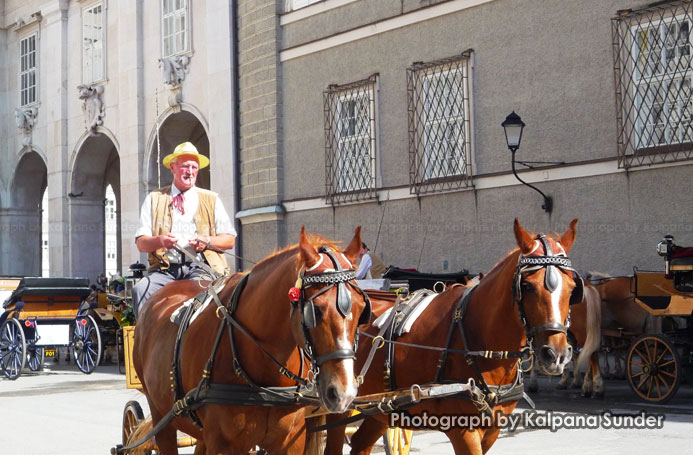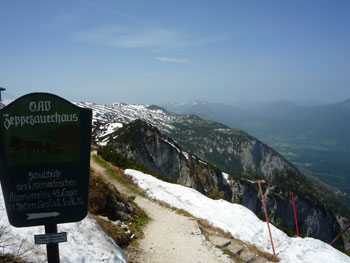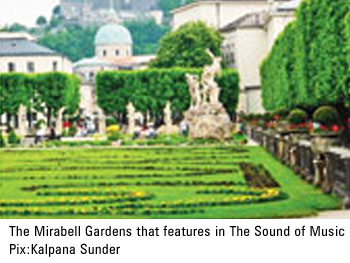
 The Sound of Music, baroque charm, panoramic views and of course, Mozart, make Salzburg a traveller’s delight, says Kalpana Sunder
The Sound of Music, baroque charm, panoramic views and of course, Mozart, make Salzburg a traveller’s delight, says Kalpana Sunder
With soaring spires, green domes, a medieval fortress standing guard over the town and a beautiful winding river — Salzburg in Austria is a chocolate-box city. Until 1816, this photogenic city was an independent principality, ruled by powerful Prince-Archbishops who have left their stamp on the city’s architecture. They designed grandiose palaces, churches and gardens using Italian craftsmen and so, wherever you look, you’ll find stucco, gold, glitter and cherubs!
Salzburg has two arrows in its quiver. The first is that The Sound of Music, possibly the most famous musical of all times, was filmed here. So you can take your pick of all of the film’s locations to visit. However, I decided against a typically touristy The Sound of Music group tour and instead, went on to discover all the locations at my own pace.
My Salzburg saga began at Mirabell gardens, where I saw the Palace of Mirabell, built by Archbishop Wolf Dietrich Raitenau for his mistress, with whom he had 16 children. An aviary, clipped hedges, artistic arbors and statues of dwarfs representing different professions filled the garden. This is where the legendary song, Do re mi, was shot and where Maria (Julie Andrews) traipsed around, teaching musical notes to the von Trapp children. After the garden, I went to visit the Palace of Leopoldskrom on the outskirts of the city, which overlooks a beautiful mirror-like lake. It’s now owned by an American organisation and is not open for public viewing, and I ended up with a mere glimpse of the palace from the other side of the lake. At any rate, I was thrilled to recognise the venue — here, the von Trapp children had fallen into the waters in the boating scene.
Next on The Sound of Music trail was the Hellbrunn Palace, built by the Prince-Archbishop Markus Sittikus in 1612. This was a summer palace, where the guests were amused by turning on jets of water in trick fountains, concealed in various seats and grottos. At the gazebo here, Liesl, the eldest of the von Trapp children, and Rolfe had sung , I am sixteen, going on seventeen. The gazebo was shifted here after some star-struck tourists tried to wreak havoc on it at the previous venue. My filmy trail ended at Mondsee in upper Austria, which features a picturesque church where Maria had wed Captain von Trapp.
 The other arrow in Salzburg’s quiver is Wolfgang Amadeus Mozart, who was born here and is possibly Salzburg’s greatest claim to fame. I visited the birthplace of the maestro on Getreidegasse — a bright yellow building with hordes of tourists milling about. I saw exhibits of the violin that he played as a child, his concert violin and also, his correspondence with the family. Among other interesting facts, I discovered that he had travelled for more than 3,000 days of his life. The stage-settings of various Mozart operas were an interesting exhibit. But having had my fill of Mozart, I skipped the house where he lived on the other side of the river and picked up some Mozartkugeln instead — the famous Mozart candy, which is a delicious mix of nougat, marzipan, pistachio and chocolate.
The other arrow in Salzburg’s quiver is Wolfgang Amadeus Mozart, who was born here and is possibly Salzburg’s greatest claim to fame. I visited the birthplace of the maestro on Getreidegasse — a bright yellow building with hordes of tourists milling about. I saw exhibits of the violin that he played as a child, his concert violin and also, his correspondence with the family. Among other interesting facts, I discovered that he had travelled for more than 3,000 days of his life. The stage-settings of various Mozart operas were an interesting exhibit. But having had my fill of Mozart, I skipped the house where he lived on the other side of the river and picked up some Mozartkugeln instead — the famous Mozart candy, which is a delicious mix of nougat, marzipan, pistachio and chocolate.
At Salzburg’s Altstadt, the historic city centre and UNESCO World Heritage Site, I visited The Residenz, the erstwhile home of Salzburg’s religious and political rulers and where young Mozart once played. It also houses an art gallery with many valuable paintings including some Titians and Rembrandts. In front of the Residenzplatz Square is a beautiful ornate fountain, flanked by many horse-drawn carriages. This city is a pedestrian’s dream. Ambling my way through the place, I browsed through some wayside stalls and sauntered towards the gorgeous Salzburg Cathedral. This majestic baroque edifice has an octagonal dome made of copper that’s visible from all over the city. Inside, the ceiling has intricate frescoes and the bronze doors in front depict Faith, Hope and Charity.
Later, I took Austria’s oldest funicular, the Festungsbahn (built in 1892 and still going strong) to the Hohensalzburg Fortress, an ancient citadel. This has been the iconic symbol of Salzburg for over 900 years and still dominates the city’s skyline. The fortress has been besieged several times but never conquered and it offers panoramic views of picture-perfect Salzburg. Inside the fortress is a self-contained city with a torture museum, old cannons, an interesting collection of marionettes in a museum and a well dating back to 1502. Nibbling on an apple strudel and taking in the sweeping vista of Salzburg spread all around, it appeared as if the slate roofs and towering turrets are all fighting for space, with the Salzach river winding and flowing through like a serpent.
My meandering continued along the Getreidegasse, which is also Salzburg’s most celebrated shopping street, with scores of intricate wrought iron signs. Here you will also find the interesting ‘through buildings’. The story goes that in ancient times, this street did not have any side streets leading off it, so walking through buildings was the only way to get to the other side. With a cappuccino in hand, I settled down to bask in the sun and indulge in some armchair sightseeing. I saw an open-air market spilling over with colourful fruits and vegetables and middle-aged men playing chess on a giant chessboard.
On the last day, I took a bus to Untersberg, a massif that straddles the German and Austrian borders. The legend of Untersberg says that Emperor Charlemagne is sleeping in the mountain and will awaken when ravens stop circling around, indicating that the empire needs him again. I took a cable car to the alpine station and trekked up a slippery path to the peak from there. However, I forgot all about the dubious trail when I reached the top for I was rewarded with a breathtaking view of the German and the Austrian Alps, the city of Salzburg far away and the lakes of this region. It was truly a fitting finale to my Salzburg sojourn!
Ready reckoner
Getting there: You can fly directly to Vienna from Delhi by Austrian Airlines. Salzburg is about three hours by train from Vienna.
Staying there: There is a wide range of accommodation available, starting from 50 euros.
Exchange rate: 1 euro = Rs 58 (approx.)
Web watch: www.salzburg.info/en/
Published in The Telegraph, 2010

